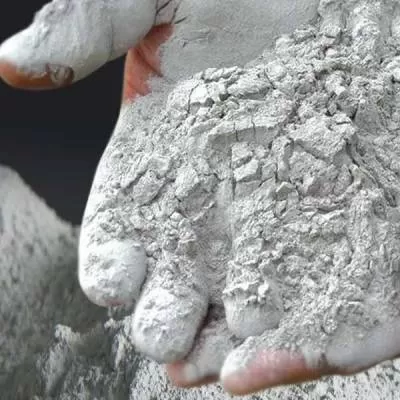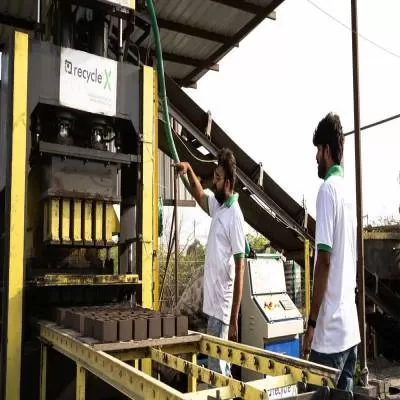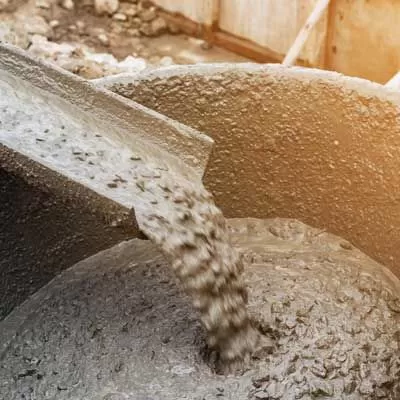- Home
- Building Material
- Cement
- The Strengths of SIFCON
The Strengths of SIFCON
Dr Ashish K Gurav, and Dr KB Prakash discuss the effect of sustained elevated temperatures on the strength properties of SIFCON produced from waste coiled steel fibres.
Concrete is probably the most widely used manmade construction material in the civil engineering world. Owing to the specialty of being cast in any shape, it has replaced the old construction techniques of stone and brick masonry. However
concrete has many deficiencies like low tensile strength, low post ing capacity, brittleness, low ductility and low impact strength.
Fibre reinforced concrete (FRC) is a composite material consisting of cement, sand, coarse aggregates, water and fibres. In this composite material, short discrete fibres are randomly distributed throughout the concrete mass. The behavioural efficiency of this composite material is far superior to that of plain concrete and any other construction material of equal cost. The addition of fibres even at relatively low volume fraction results in observable improvements in structural behaviour. Owing to these benefits, the use of FRC has steadily increased in the past two decades. Its current field of application includes airport and highway pavements, earthquake resistance and explosive resistant structures, mine and tunnel linings, bridge deck overlays, hydraulic structures, and rock slope stabilisation.
Slurry infiltrated fibre-reinforced concrete (SIFCON), is a relatively recent development in the field of FRC. It was invented by Lankard in 1979. SIFCON is a fabrication method in which steel fibres are pre-placed in the form or in the mould to its full capacity, rather than being mixed and then cast or sprayed along with concrete. After placement of fibres, fine-grained cement based slurry is poured or pumped into the fibre network, infiltrating the air space between the fibres while conforming to the shape of the form or mould. External vibrations can also be used to aid infiltration of the slurry. The main advantage of SIFCON is that very high steel fibre contents can be obtained. The current practical range of fibre volume for SIFCON is 4-12 per cent. With fibre content of this magnitude, dramatic increase in strength and ductility can be expected.
Waste coiled steel fibres obtained from lathe machine shops can be used to produce SIFCON. These fibres are available in plenty in any industrial area at cheap rates. Owing to their coiled nature, they may offer more resistance to loads. The study of the effect of elevated temperatures on SIFCON produced from such waste coiled fibres may result in an economic building material for elevated temperature applications.
The study
The main aim of this study was to ascertain the effect of sustained elevated temperatures on the strength properties of SIFCON produced from waste coiled steel fibres. Ordinary Portland Cement (OPC) of 53 grade and locally available sand with a specific gravity of 2.65 and fineness modulus of 2.92 were used. To impart additional workability, superplasticizer (1 per cent by weight of cement) was used. The waste coiled steel fibres were procured from local lathe machine shops. The fibres were of chrome steel with a density of 6.8 gm/cm. The average thickness of fibres was taken into consideration in fixing the aspect ratios. The percentage of fibres used in the experimentation was 8 per cent. The average thickness was 0.5 mm, with average coil diameter of 3 mm. The different aspect ratios adopted in the experimentation were 80, 90, 100, 110 and 120 with fibre lengths of 40 mm, 45 mm, 50 mm, 55 mm and 60 mm respectively.
The cement-mortar slurry was prepared with 1:1 proportion using w/c ratio 0.42. Superplasticizer was added to increase infiltration capacity. The moulds were filled with 8 per cent fibres and slurry was poured into the moulds. Vibration was given to the moulds with a table vibrator. The slurry was poured until no more bubbles were seen. This ensured thorough infiltration of slurry into the fibres. After 24 hours, the specimens were de-moulded and transferred to a curing tank for 28 days.
The effect of sustained elevated temperatures on SIFCON was studied on compressive, tensile, flexural and impact strengths. The specimens were cast in four groups. One group was intended for testing at room temperature while the other three were intended for testing after being subjected to temperatures like 200oC, 400oC and 600oC respectively.
Cube specimens of 150×150×150 mm were cast, from which compressive strength was calculated. Specimens of 150 mm diameter and 300 mm length were cast for split tensile strength test while those of 100×100×500 mm were cast for flexural strength test. Two-point loading was adopted on these specimens with an effective span of 400 mm. The impact strength specimens consisted of plates of 250×250×35 mm. For this test, the drop weight method was used owing to its simplicity. A steel ball weighing 20 n (Newton) was dropped from a height of 1 m over the specimen. The number of blows required to cause complete failure were noted and the impact energy was calculated as follows:
Impact energy = w × h × n (n-m).
Where w = weight of the ball = 20 n
h = height of fall = 1 m
n = number of blows required to cause complete failure.
After 28 days of curing, the specimens were taken out of the water. The three groups of specimens were then transferred to an oven where they were exposed to a temperature of 200oC, 400oC and 600oC respectively, for 24 hours. After 24 hours they were taken out from the oven and allowed to cool for 24 hours. After cooling, they were tested for their respective strengths.
Test results
Tables 1 to 4 give the results for compressive, tensile, flexural and impact strength tests respectively for SIFCON, with and without being subjected to elevated temperatures. The tables also indicate the percentage decrease in the strength of SIFCON when subjected to these temperatures. Figures 1 to 4 give variation of compressive, tensile, flexural and impact strengths for SIFCON, with and without being subjected to elevated temperatures.
Here is a summary of the findings:
● The compressive, tensile, flexural and impact strengths of SIFCON go on increasing as the aspect ratio of fibres goes on increasing. This is true for SIFCON with or without being subjected to elevated temperatures. This may be because of optimum infiltration of slurry for fibres with an aspect ratio of 120. Thus, it can be concluded that the SIFCON produced with fibres with an aspect ratio of 120 yields the maximum strength.
● Percentage reduction in the compressive strength of SIFCON is 2-4 per cent when subjected to a temperature of 200oC. For temperatures of 400oC and 600oC, it is 15-18 per cent and 34-37 per cent respectively compared to the reference mix.
● Percentage reduction in the tensile strength of SIFCON is 3-5 per cent when subjected to a temperature of 200oC. For temperatures of 400oC and 600oC, it is 13-18 per cent and 35-40 per cent respectively compared to the reference mix.
● Percentage reduction in the flexural strength of SIFCON is 3-5 per cent when subjected to a temperature of 200oC. For temperatures of 400oC and 600oC, it is 16-20 per cent and 37-43 per cent respectively compared to the reference mix.
● Percentage reduction in the impact strength of SIFCON is 3-5 per cent when subjected to a temperature of 200oC. For temperatures of 400oC and 600oC, it is 15-20 per cent and 38-42 per cent respectively compared to the reference mix.
● Thus it is observed that SIFCON subjected to temperature of 600oC undergoes much more reduction in strengths compared to SIFCON subjected to temperature of 200oC and 400oC. This may because of more expansion of fibres at 600oC, which results in disruption of concrete and development of micro-s, leading to lower strengths.
Dr Ashish K Gurav, and Dr KB Prakash discuss the effect of sustained elevated temperatures on the strength properties of SIFCON produced from waste coiled steel fibres. Concrete is probably the most widely used manmade construction material in the civil engineering world. Owing to the specialty of being cast in any shape, it has replaced the old construction techniques of stone and brick masonry. However concrete has many deficiencies like low tensile strength, low post ing capacity, brittleness, low ductility and low impact strength. Fibre reinforced concrete (FRC) is a composite material consisting of cement, sand, coarse aggregates, water and fibres. In this composite material, short discrete fibres are randomly distributed throughout the concrete mass. The behavioural efficiency of this composite material is far superior to that of plain concrete and any other construction material of equal cost. The addition of fibres even at relatively low volume fraction results in observable improvements in structural behaviour. Owing to these benefits, the use of FRC has steadily increased in the past two decades. Its current field of application includes airport and highway pavements, earthquake resistance and explosive resistant structures, mine and tunnel linings, bridge deck overlays, hydraulic structures, and rock slope stabilisation. Slurry infiltrated fibre-reinforced concrete (SIFCON), is a relatively recent development in the field of FRC. It was invented by Lankard in 1979. SIFCON is a fabrication method in which steel fibres are pre-placed in the form or in the mould to its full capacity, rather than being mixed and then cast or sprayed along with concrete. After placement of fibres, fine-grained cement based slurry is poured or pumped into the fibre network, infiltrating the air space between the fibres while conforming to the shape of the form or mould. External vibrations can also be used to aid infiltration of the slurry. The main advantage of SIFCON is that very high steel fibre contents can be obtained. The current practical range of fibre volume for SIFCON is 4-12 per cent. With fibre content of this magnitude, dramatic increase in strength and ductility can be expected. Waste coiled steel fibres obtained from lathe machine shops can be used to produce SIFCON. These fibres are available in plenty in any industrial area at cheap rates. Owing to their coiled nature, they may offer more resistance to loads. The study of the effect of elevated temperatures on SIFCON produced from such waste coiled fibres may result in an economic building material for elevated temperature applications. The study The main aim of this study was to ascertain the effect of sustained elevated temperatures on the strength properties of SIFCON produced from waste coiled steel fibres. Ordinary Portland Cement (OPC) of 53 grade and locally available sand with a specific gravity of 2.65 and fineness modulus of 2.92 were used. To impart additional workability, superplasticizer (1 per cent by weight of cement) was used. The waste coiled steel fibres were procured from local lathe machine shops. The fibres were of chrome steel with a density of 6.8 gm/cm. The average thickness of fibres was taken into consideration in fixing the aspect ratios. The percentage of fibres used in the experimentation was 8 per cent. The average thickness was 0.5 mm, with average coil diameter of 3 mm. The different aspect ratios adopted in the experimentation were 80, 90, 100, 110 and 120 with fibre lengths of 40 mm, 45 mm, 50 mm, 55 mm and 60 mm respectively. The cement-mortar slurry was prepared with 1:1 proportion using w/c ratio 0.42. Superplasticizer was added to increase infiltration capacity. The moulds were filled with 8 per cent fibres and slurry was poured into the moulds. Vibration was given to the moulds with a table vibrator. The slurry was poured until no more bubbles were seen. This ensured thorough infiltration of slurry into the fibres. After 24 hours, the specimens were de-moulded and transferred to a curing tank for 28 days. The effect of sustained elevated temperatures on SIFCON was studied on compressive, tensile, flexural and impact strengths. The specimens were cast in four groups. One group was intended for testing at room temperature while the other three were intended for testing after being subjected to temperatures like 200oC, 400oC and 600oC respectively. Cube specimens of 150×150×150 mm were cast, from which compressive strength was calculated. Specimens of 150 mm diameter and 300 mm length were cast for split tensile strength test while those of 100×100×500 mm were cast for flexural strength test. Two-point loading was adopted on these specimens with an effective span of 400 mm. The impact strength specimens consisted of plates of 250×250×35 mm. For this test, the drop weight method was used owing to its simplicity. A steel ball weighing 20 n (Newton) was dropped from a height of 1 m over the specimen. The number of blows required to cause complete failure were noted and the impact energy was calculated as follows: Impact energy = w × h × n (n-m). Where w = weight of the ball = 20 n h = height of fall = 1 m n = number of blows required to cause complete failure. After 28 days of curing, the specimens were taken out of the water. The three groups of specimens were then transferred to an oven where they were exposed to a temperature of 200oC, 400oC and 600oC respectively, for 24 hours. After 24 hours they were taken out from the oven and allowed to cool for 24 hours. After cooling, they were tested for their respective strengths. Test results Tables 1 to 4 give the results for compressive, tensile, flexural and impact strength tests respectively for SIFCON, with and without being subjected to elevated temperatures. The tables also indicate the percentage decrease in the strength of SIFCON when subjected to these temperatures. Figures 1 to 4 give variation of compressive, tensile, flexural and impact strengths for SIFCON, with and without being subjected to elevated temperatures. Here is a summary of the findings: ● The compressive, tensile, flexural and impact strengths of SIFCON go on increasing as the aspect ratio of fibres goes on increasing. This is true for SIFCON with or without being subjected to elevated temperatures. This may be because of optimum infiltration of slurry for fibres with an aspect ratio of 120. Thus, it can be concluded that the SIFCON produced with fibres with an aspect ratio of 120 yields the maximum strength.● Percentage reduction in the compressive strength of SIFCON is 2-4 per cent when subjected to a temperature of 200oC. For temperatures of 400oC and 600oC, it is 15-18 per cent and 34-37 per cent respectively compared to the reference mix.● Percentage reduction in the tensile strength of SIFCON is 3-5 per cent when subjected to a temperature of 200oC. For temperatures of 400oC and 600oC, it is 13-18 per cent and 35-40 per cent respectively compared to the reference mix.● Percentage reduction in the flexural strength of SIFCON is 3-5 per cent when subjected to a temperature of 200oC. For temperatures of 400oC and 600oC, it is 16-20 per cent and 37-43 per cent respectively compared to the reference mix.● Percentage reduction in the impact strength of SIFCON is 3-5 per cent when subjected to a temperature of 200oC. For temperatures of 400oC and 600oC, it is 15-20 per cent and 38-42 per cent respectively compared to the reference mix.● Thus it is observed that SIFCON subjected to temperature of 600oC undergoes much more reduction in strengths compared to SIFCON subjected to temperature of 200oC and 400oC. This may because of more expansion of fibres at 600oC, which results in disruption of concrete and development of micro-s, leading to lower strengths.






















